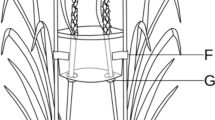Abstract
Waggle-dancing honeybee foragers emit four hydrocarbons that have been shown to stimulate colony foraging by reactivating experienced foragers and increasing the number of recruitment dances. These hydrocarbons, the alkanes tricosane and pentacosane, and the alkenes (Z)-9-tricosene and (Z)-9-pentacosene, are part of the array of social insects cuticular lipids which have been well studied in the context of nestmate recognition. This study seeks to determine which of the dance hydrocarbons produce the behavioral responses of forager bees by using a binary choice behavioral assay for attraction or repulsion to the volatile phase of the dance compounds. We found no significant deviation from random choice for single dance compounds and pairs of compounds, but bees were significantly attracted to a mixture of the three compounds (Z)-9-tricosene, tricosane, and pentacosane. These results suggest synergy among the waggle-dance hydrocarbons, which was unexpected based on previous research where, in the context of nestmate recognition, alkenes have been shown to play a key role in eliciting behavioral responses. Synergy among the waggle-dance hydrocarbons may provide specificity that facilitates adaptive, context-specific behavioral responses to this subset of cuticular hydrocarbons.


Similar content being viewed by others
References
Breed MD (1998) Recognition pheromones of the honeybee. Bioscience 48(6):463–470
Breed MD, Cook CN, McCreery HF, Rodriguez M (2015) Nestmate recognition in eusocial insects: the honeybee as a model system. In: Aquiloni L, Tricarico E (eds) Social Recognition in Invertebrates. Springer, Cham, pp 147–164
Châline N, Sandoz JC, Martin SJ, Ratnieks FL, Jones GR (2005) Learning and discrimination of individual cuticular hydrocarbons by honeybees (Apis mellifera). Chem Senses 30(4):327–335
Dani FR (2006) Cuticular lipids as semiochemicals in paper wasps and other social insects. Annales Zoologici Fennici 43:500–514
Dani FR, Jones GR, Destri S, Spencer SH, Turillazzi S (2001) Deciphering the recognition signature within the cuticular chemical profile of paper wasps. Anim Behav 62(1):165–171
Dani FR, Jones GR, Corsi S, Beard R, Pradella D, Turillazzi S (2005) Nestmate recognition cues in the honeybee: differential importance of cuticular alkanes and alkenes. Chem Senses 30(6):477–489
Getz WM, Smith KB (1987) Olfactory sensitivity and discrimination of mixtures in the honeybee Apis mellifera. J Comp Physiol A 160(2):239–245
Gibbs AG (1998) Water-proofing properties of cuticular lipids. Am Zool 38(3):471–482
Gilley DC (2014) Hydrocarbons emitted by waggle-dancing honeybees increase forager recruitment by stimulating dancing. PLoS One 9(8):e105671
Gilley DC, Kuzora JM, Thom C (2012) Hydrocarbons emitted by waggle-dancing honeybees stimulate colony foraging activity by causing experienced foragers to exploit known food sources. Apidologie 43(1):85–94
Greene MJ, Gordon DM (2007) Structural complexity of chemical recognition cues affects the perception of group membership in the ants Linephithema humile and Aphaenogaster cockerelli. J Exp Biol 210(5):897–905
Howard RW, Blomquist GJ (2005) Ecological, behavioral, and biochemical aspects of insect hydrocarbons. Annu Rev Entomol 50:371–393
Kather R, Drijfhout FP, Martin SJ (2011) Task group differences in cuticular lipids in the honeybee Apis mellifera. J Chem Ecol 37(2):205–212
Le Conte Y, Hefetz A (2008) Primer pheromones in social hymenoptera. Annu Rev Entomol 53:523–542
Martin SJ, Drijfhout FP (2009) Nestmate and task cues are influenced and encoded differently within ant cuticular hydrocarbon profiles. J Chem Ecol 35(3):368–374
Rohlf FJ, Sokal RR (1995) Statistical tables. Freeman & Company, New York
Sokal RR, Rohlf FJ (1995) Biometry: the principles and practice of statistics in biological research. Freeman & Company, New York
Thom C, Gilley DC, Hooper J, Esch HE (2007) The scent of the waggle dance. PLoS Biol 5(9):e228
van Wilgenburg E, Felden A, Choe DH, Sulc R, Luo J, Shea KJ, Elgar MA, Tsutsui ND (2011) Learning and discrimination of cuticular hydrocarbons in a social insect. Biol Lett. https://doi.org/10.1098/rsbl.2011.0643
Wagner D, Tissot M, Gordon D (2001) Task-related environment alters the cuticular hydrocarbon composition of harvester ants. J Chem Ecol 27(9):1805–1819
Wyatt TD (2014) Pheromones and animal behavior: chemical signals and signatures. Cambridge University Press, New York
Acknowledgements
We would like to thank Erin Crehan, Adalyne Arafet, and Virginia Rock for their indispensable help collecting data for this study. NM and TC were supported by the Louis Stokes Alliance for Minority Participation in the Sciences and the William Paterson University Student Research and Creative Expression Program. DG was supported by the William Paterson University Assigned Release Time Program.
Author information
Authors and Affiliations
Corresponding author
Rights and permissions
About this article
Cite this article
Gilley, D.C., Miller, N., Courtright, T.J. et al. Behavioral Activity of Hydrocarbons Emitted by Honeybee Waggle Dancers. J Insect Behav 31, 83–90 (2018). https://doi.org/10.1007/s10905-018-9664-2
Revised:
Accepted:
Published:
Issue Date:
DOI: https://doi.org/10.1007/s10905-018-9664-2




